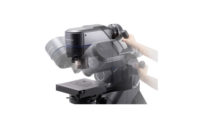Essential Considerations for Manufacturers About Measuring Microscopes

A host of tools are available to metrologists in today’s manufacturing environment. Many are simple, mechanical, and accessible to anyone who wants to measure something. Others are high-tech, even futuristic. Some, like the measuring microscope, might be considered a hybrid of the two. In addition to all the benefits measuring microscopes can bring to manufacturing applications, two very important ones—calibration and fixturing—cannot be overlooked.
Traceable Calibration
When measuring in a manufacturing setting, particularly in a high-volume application, calibration is important for accuracy, repeatability, and reproducibility. This is especially true for very small measurements made with a measuring microscope.
According to Frank Lafleur, senior product manager of Olympus industrial microscopy, “Without microscope calibration, it is impossible to trust fully in any measurement taken. Even within precision optical components, there is still a small [up to 2% in precision optics, 7+% in budget optics] variation in measurements. As these minute errors are compounded within the system, they could potentially make the difference between a component passing or failing, and so a non-calibrated unit could allow unacceptable components to pass quality inspection. This uncertainty can be removed by calibrating a microscope to a traceable standard.”
The benefits of efficiency and ease in the physical and optical calibration is paramount for a high-quality measuring microscope.
“The Olympus STM7 measuring microscope is calibrated both optically for measurements on screen within the field of view, and physically by precisely calibrating the encoders built into the stage,” says Hamish Rossell, product applications manager of Olympus. “This allows it to measure across the entire travel of the stage within a known tolerance. This calibration is NIST [National Institute of Standards and Technology] traceable, providing confidence in the measurement of large and very precise parts.”
Flexible Fixturing
In metrology, another important aspect of taking measurements is ensuring that your instrument does not move. This notion applies to microscopic measurements using a measuring microscope. And, although it sounds like a paradox, an inflexible measuring platform often requires a flexible fixturing system.
“The STM7 is available with a variety of stage options ranging in size from 50 mm square to 300 mm square,” says Lafleur. “These stages can be configured with different stage inserts including glass plates for transmitted light options and with rotating stages. As the stage insert is removable and the stage has multiple fixture points, custom fixturing is easily possible.”
In a high-volume manufacturing operation, flexible fixturing is an important asset.
“By using a fixture, the STM7’s laser autofocus, and the STM7 software’s built-in coordinate system, a component can quickly be loaded and accurate measurements acquired,” says Rossell. “As the STM7 microscope can accept multiple fixtures and coordinate maps, there’s no requirement for a skilled operator to regularly reprogram the inspection.”
Optical Comparator vs. Measuring Microscope
Traditionally, optical comparators have been used in many manufacturing inspection environments. With these devices, users perform geometric and dimensional measurements on a magnified silhouette of the part to compare it against the specs and requirements. However, optical comparators are large, cost-prohibitive instruments that require a lot of floor space. A measuring microscope can help alleviate these concerns and provide other benefits as well.
“An optical comparator is bound purely by the field of view, and often just by the silhouette of the component (though modern comparators have gotten more sophisticated),” says Lafleur. “The STM7 can easily work as an optical comparator, with its telecentric optics and transmitted light options, but can also work as a reflected light microscope, enabling precise inspection of fine detail that would otherwise not be detectable by a conventional comparator tool.”
A measuring microscope also can offer a means of direct comparison.
“The STM7 microscope can be programed with a coordinate-based inspection routine, where it will provide guidance to each measurement, automatically focus, switch to the correct illumination configuration, and automatically select the necessary measurement tool,” says Rossell. “These measurements are then compared against entered design values and tolerances. This routine can be run multiple times, recording the results either within the software or exported to excel, allowing the easy analysis of trends.”
For more information, visit www.olympus-ims.com.
Looking for a reprint of this article?
From high-res PDFs to custom plaques, order your copy today!







